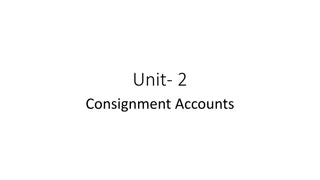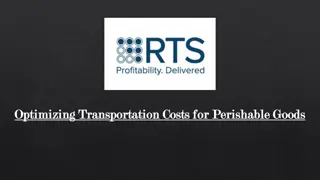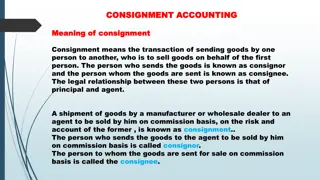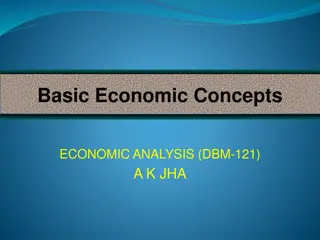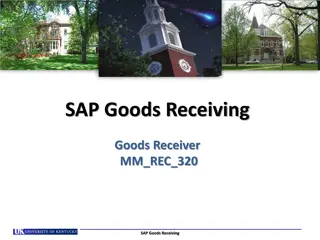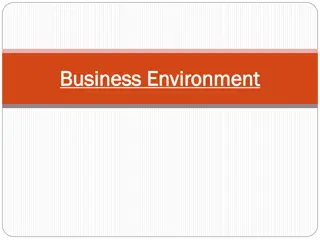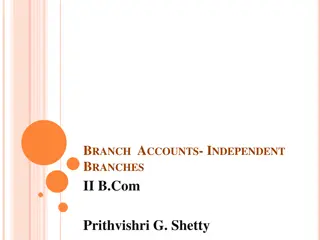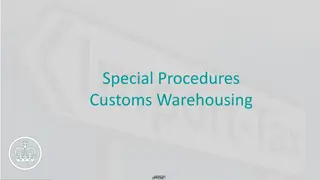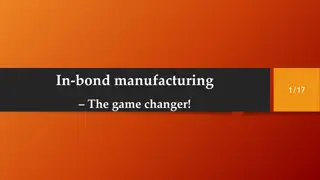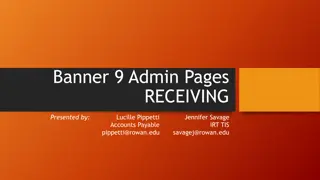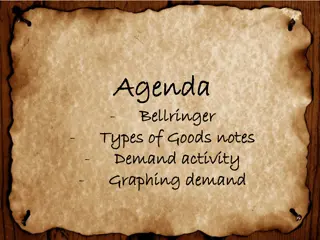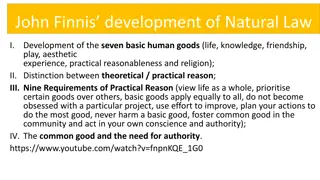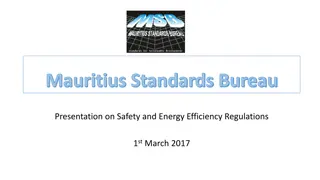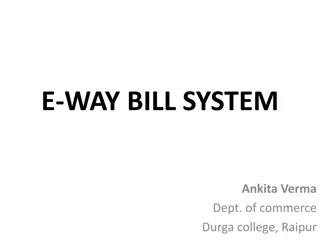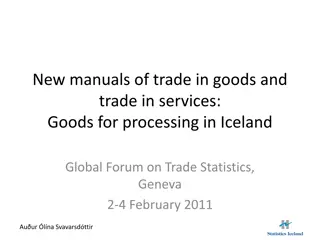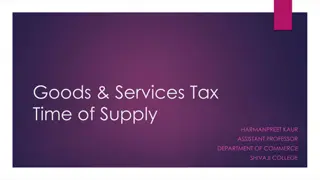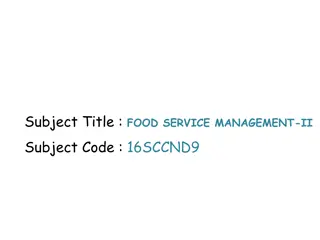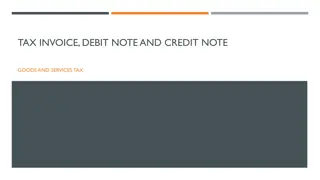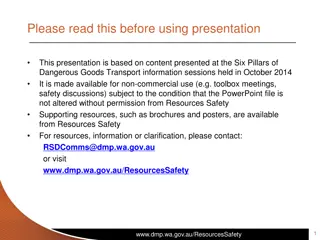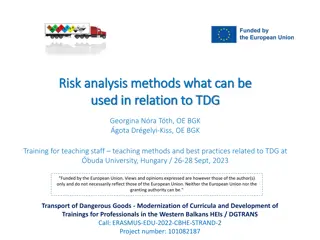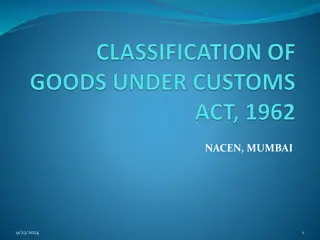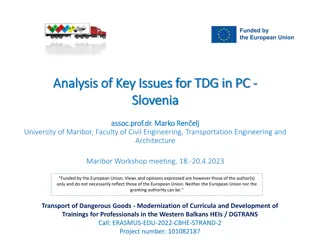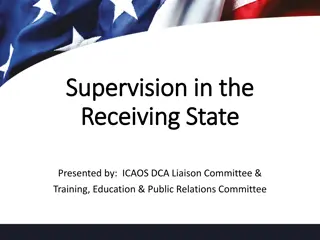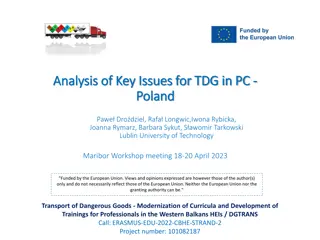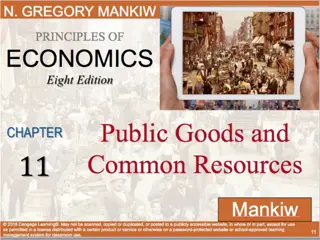Partner NNGO Capacity Strengthening. Basics in Procurement and Goods, Services and Works Receiving
This guide by Marin Tomas from International Medical Corps covers key areas for organizations handling funds, emphasizing efficient budget management, transparent procurement, and effective project implementation. It also outlines primary accountability areas for logistics, such as procurement, stor
0 views • 48 slides
Understanding Consignment Accounts in Business
Consignment accounts involve the sending of goods by a consignor to a consignee for sale on the consignor's behalf. The consignor remains the owner of the goods until they are sold, and the consignee sells the goods, collects money from customers, and receives commissions. Various types of commissio
9 views • 22 slides
Factors Influencing Economic Growth: Human Capital and Capital Goods
Factors such as investment in human capital, capital goods, natural resources, and entrepreneurship play a crucial role in determining a country's economic growth. Human capital encompasses the skills and abilities of workers, while capital goods are the tools and equipment used to produce goods and
2 views • 28 slides
ABMN 0511 - RURAL MARKETING
Rural marketing in India involves the flow of goods and services from producers to rural consumers, encompassing demand estimation, product planning, distribution, and ensuring consumer satisfaction. Key components of rural markets include the presence of goods for transactions, buyers and sellers,
1 views • 15 slides
Optimizing Transportation Costs for Perishable Goods
In the realm of logistics, the transportation of perishable goods presents a unique challenge. From fresh produce to pharmaceuticals, these time-sensitive commodities require specialized handling and efficient transportation to maintain their quality and integrity. One of the critical aspects of man
2 views • 6 slides
Understanding Consignment in Accounting
Consignment in accounting involves sending goods from a consignor to a consignee for sale on commission basis. The consignor retains ownership until the goods are sold. The relationship is that of principal and agent, with the consignee handling sales and remitting net proceeds. Important terms incl
1 views • 7 slides
Mastering Desktop Receiving in PeopleSoft eProcurement
Explore the functionality of desktop receiving in the PeopleSoft eProcurement module to efficiently manage goods receipt processes in your department. Learn how to receive, review, sort, and reject ePro goods, along with creating desktop receipts for Office Depot Purchase Orders. Understand the step
0 views • 14 slides
Understanding Basic Economic Concepts: Needs, Wants, Goods, and Services
Exploring fundamental economic concepts such as needs versus wants, goods, services, and products. Learn about the differences between goods and services, types of goods related to income, types of goods related to price, and types of goods related to consumption ability.
0 views • 11 slides
SAP Goods Receiving Training Overview
SAP Goods Receiving training covers the process of confirming receipt of goods or services within a department. It includes roles, training requirements, process flow, transaction codes, and various functionalities related to Goods Receiving in SAP. The training targets individuals authorized to rec
1 views • 52 slides
Understanding Business Environment and Objectives
Business encompasses a wide range of activities related to the production and distribution of goods and services, influenced by various interpretations from consumers, governments, and environmentalists. It involves activities like buying, selling, manufacturing, and service provision, all aimed at
0 views • 61 slides
Understanding Independent Branches in Accounting
Independent branches in accounting operate autonomously, making purchases externally, receiving goods from the head office, setting their selling prices, and managing expenses from their own cash flow. They keep complete books, prepare financial statements independently, and may engage in inter-bran
1 views • 10 slides
Understanding Customs Warehousing and Simplified Customs Declaration Procedures
Customs Warehousing is a special procedure that allows goods to be stored in the UK while customs duties and import VAT are suspended. It aims to facilitate trade by providing duty suspension for businesses importing goods from other countries. Additionally, the Simplified Customs Declaration Proced
1 views • 23 slides
In-Bond Manufacturing: A Game Changer in Customs Regulations
In-bond manufacturing allows for certain operations to be carried out on warehoused goods without payment of customs duties, benefiting businesses by facilitating cash flow and ease of doing business. The process involves obtaining permission, following specific regulations, and potentially exportin
1 views • 17 slides
Comprehensive Guide to Banner 9 Admin Pages Receiving Process
Delve into the intricacies of handling receiving tasks in Banner 9 Admin Pages with detailed guidance on different types of receiving, processing multiple items on a purchase order, using tools menu efficiently, and ensuring accurate completion of receiving tasks. This comprehensive guide provides v
0 views • 26 slides
Brexit VAT Treatment of Goods and Services Overview
The Brexit VAT treatment of goods and services impacts cross-border supplies to the UK, VAT refunds for goods, separation provisions under the Withdrawal Agreement, and the Ireland/Northern Ireland Protocol. Changes in VAT regulations and protocols are outlined for businesses and traders within the
3 views • 10 slides
Understanding Types of Goods and Demand in Economics
Explore the concepts of normal versus inferior goods, the law of demand, and graphing demand curves in economics. Learn how income changes affect consumer behavior with examples of goods and services. Understand how to identify normal and inferior goods based on consumer preferences and income level
0 views • 11 slides
Understanding the Installment Purchase System
The installment purchase system is similar to credit and hire purchase systems, allowing buyers to make payments in installments over a period of time. The buyer gets possession and ownership of the goods immediately, but if there's a default in payment, the vendor can't repossess the goods. Instead
0 views • 4 slides
John Finnis' Development of Natural Law and Basic Human Goods
John Finnis' theory of natural law focuses on the development of seven basic human goods, including life, knowledge, friendship, play, aesthetic experience, practical reasonableness, and religion. He emphasizes the distinction between theoretical and practical reason, outlines nine requirements of p
0 views • 14 slides
Understanding the Theory of Demand in Microeconomics
The theory of demand in microeconomics explores the concept of consumer willingness and ability to purchase goods and services at various prices. Factors influencing demand include price, related commodity prices, income levels, consumer preferences, population size, and distribution of income. The
1 views • 13 slides
Safety and Energy Efficiency Regulations Overview by Mauritius Standards Bureau
Explore the comprehensive overview of safety and energy efficiency regulations presented by the Mauritius Standards Bureau on 1st March 2017. The presentation covers important topics such as the Consumer Protection Act, Controlled Goods, Energy Efficiency Act, verification of Certificates of Conform
0 views • 15 slides
Understanding Public Goods in Higher Education
This text delves into the concept of public goods in higher education, examining the distinctions between public and private forms, the economic and political dimensions, and the normative value of public goods. It discusses the economic definition of public goods, emphasizing their non-rivalrous an
1 views • 18 slides
Understanding the E-Way Bill System in India
The E-Way Bill System in India mandates the electronic submission of information for goods exceeding Rs. 50,000 before movement. This system aims to facilitate nationwide goods movement, reduce corruption, and enhance tax compliance. Traders benefit from streamlined processes and reduced waiting tim
0 views • 11 slides
Trade Manual Updates: Goods Processing in Iceland
Explore the new and old manuals for trade in goods and services, focusing on goods processing in Iceland. Understand the changes in treatment, coverage, and implications for trade statistics. Learn about Iceland's role as a processing country in the metal industry, highlighting imports, exports, and
0 views • 23 slides
Pathpoint Coverage for Candles and Leather Goods Manufacturing
Explore the insurance coverage provided by Pathpoint for candles and leather goods manufacturing. Learn about the eligibility criteria for leather products and the types of candles covered. Discover the wide range of eligible leather goods and the details of coverage available, including general lia
0 views • 17 slides
Understanding Goods and Services Tax (GST) Time of Supply
Goods and Services Tax (GST) time of supply, also known as TOS, determines when GST becomes payable on a supply. This includes various elements like agreement to supply, delivery of goods, provision of services, invoice issuance, payment, and recording of payments. The time of supply for goods and s
0 views • 26 slides
Food Service Management II - Purchasing, Receiving & Storing
Understanding the crucial aspects of purchasing, receiving, and storing in food service management is essential for smooth operations. Purchasing involves acquiring the right products at the right time and price, while receiving and storing ensure food quality and safety. Key functions include menu
0 views • 35 slides
Understanding Tax Invoices, Debit Notes, and Credit Notes in Goods and Services Tax
This content covers the basic concepts of supply, invoicing obligations, tax invoices under Section 28, removal of goods for supply, and scenarios where removal does not result in a supply. Learn about the different types of taxes and when tax invoices should be issued for taxable goods and services
0 views • 28 slides
Customs Brokers Licensing Training Program: Entry and Examination Procedures
This presentation covers the essential aspects of entry and examination procedures for imported goods, detailing the responsibilities of importers, examination stations at customs airports, customs possession of delayed goods, special inspections, and cost implications. It emphasizes the legal requi
0 views • 15 slides
Important Information on Dangerous Goods Transport
This presentation provides essential details on the Six Pillars of Dangerous Goods Transport, emphasizing the significance of proper documentation, emergency procedures, and regulatory compliance. It highlights the necessity of transport documents for class 6, 8, or division 2.3 dangerous goods, out
0 views • 16 slides
Understanding Segregation of Dangerous Goods in Transport
This presentation provides valuable information on the segregation of dangerous goods for transport, based on the Six Pillars of Dangerous Goods Transport. It covers topics such as what dangerous goods to segregate, how to segregate them, and includes practical examples. Important examples of incomp
0 views • 12 slides
Risk Analysis Methods Related to Transport of Dangerous Goods at Buda University, Hungary
Explore risk analysis methods in relation to Transport of Dangerous Goods (TDG) at Buda University, Hungary. Discover best practices for teaching staff through funded training programs aimed at modernizing curricula and developing professionals in the Western Balkans. Learn about European recommenda
0 views • 30 slides
Guidelines for Harmonized System Classification of Goods
Understand the step-by-step process of classifying goods under the Harmonized System, including referencing section notes and chapter notes, resolving ambiguities in word meanings, identifying essential characteristics of unfinished goods, choosing specific headings over general ones, and classifyin
0 views • 41 slides
Challenges and Trends in the Sporting Goods Industry
The sporting goods industry has faced challenges such as store closures, bankruptcies, and shifting consumer preferences. Sales in sporting goods stores remained relatively stable from 2015 to 2016, but a significant decrease was seen in the first seven months of 2017. Participation in physical acti
0 views • 10 slides
Analysis of Key Issues for Transport of Dangerous Goods in Slovenia
This analysis focuses on the legal bases and regulations governing the transportation and inspection of dangerous goods in Slovenia, covering aspects such as international agreements, EU requirements, specific legislation for different modes of transportation, and the Dangerous Goods Transport Act.
0 views • 11 slides
Supervision Considerations in Receiving States for Compact Offenders
Explore key training objectives, response to pending charges, and revocable behaviors in supervising compact offenders in receiving states. Learn about the importance of identifying and reporting new offenses and court-related information. Understand the issues surrounding permanent revocation and d
0 views • 22 slides
Modernization of Transport of Dangerous Goods in Poland
Analysis of key issues related to the transport of dangerous goods (TDG) in Poland, focusing on tools, methods, standards, and programs involved in the TDG chain, including the relevant legislation such as the Act on the Carriage of Dangerous Goods and the ADR Agreement. The ADR covers general provi
0 views • 11 slides
Understanding Public Goods and Common Resources
Exploring concepts like private goods, public goods, common resources, free rider problem, Tragedy of the Commons, and cost-benefit analysis in economics, this content helps differentiate between types of goods and resources, providing insights into the challenges and considerations associated with
0 views • 15 slides
Reflections on Giving and Receiving
Reflect on the interconnected nature of giving and receiving in life, drawing inspiration from quotes about the law of giving, the power of generosity, and the importance of balance in various aspects of living. Explore the idea of reciprocity and the beauty of both giving and receiving in this coll
0 views • 9 slides
The Role of Public Goods in Higher Education
This paper discusses the concept of public goods in higher education, exploring how they are defined, observed, and improved. It analyzes the distinctions between public and private goods based on economic and juridical-political factors, and examines the significance of public goods in advancing so
0 views • 19 slides
Exploring the Theme of Giving and Receiving Through Scripture and Liturgy
Delve into the important lesson of giving and receiving as taught in Acts 20:35 through a comprehensive educational approach. Engage in activities like Lectio Divina, reflection on personal experiences, and planning a liturgy to understand the significance of generosity. This unit encourages contemp
0 views • 4 slides

